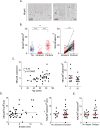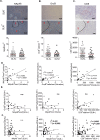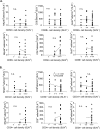Characterization of the Microenvironment in Positive and Negative Sentinel Lymph Nodes from Melanoma Patients
- PMID: 26218530
- PMCID: PMC4517810
- DOI: 10.1371/journal.pone.0133363
Characterization of the Microenvironment in Positive and Negative Sentinel Lymph Nodes from Melanoma Patients
Abstract
Melanomas are aggressive skin tumors characterized by high metastatic potential. Our previous results indicate that Natural Killer (NK) cells may control growth of melanoma. The main defect of blood NK cells was a decreased expression of activating NCR1/NKp46 receptor and a positive correlation of NKp46 expression with disease outcome in stage IV melanoma patients was found. In addition, in stage III melanoma patients, we identified a new subset of mature NK cells in macro-metastatic Lymph nodes (LN). In the present studies, we evaluated the numbers of NK cells infiltrating primary cutaneous melanoma and analyzed immune cell subsets in a series of sentinel lymph nodes (SLN). First, we show that NKp46+ NK cells infiltrate primary cutaneous melanoma. Their numbers were related to age of patients and not to Breslow thickness. Then, a series of patients with tumor-negative or -positive sentinel lymph nodes matched for Breslow thickness of the cutaneous melanoma was constituted. We investigated the distribution of macrophages (CD68), endothelial cells, NK cells, granzyme B positive (GrzB+) cells and CD8+ T cells in the SLN. Negative SLN (SLN-) were characterized by frequent adipose involution and follicular hyperplasia compared to positive SLN (SLN+). High densities of macrophages and endothelial cells (CD34), prominent in SLN+, infiltrate SLN and may reflect a tumor favorable microenvironment. Few but similar numbers of NK and GrzB+ cells were found in SLN- and SLN+: NK cells and GrzB+ cells were not correlated. Numerous CD8+ T cells infiltrated SLN with a trend for higher numbers in SLN-. Moreover, CD8+ T cells and GrzB+ cells correlated in SLN- not in SLN+. We also observed that the numbers of CD8+ T cells negatively correlated with endothelial cells in SLN-. The numbers of NK, GrzB+ or CD8+ T cells had no significant impact on overall survival. However, we found that the 5 year-relapse rate was higher in SLN with higher numbers of NK cells.
Conflict of interest statement
Figures





Similar articles
-
Mature cytotoxic CD56(bright)/CD16(+) natural killer cells can infiltrate lymph nodes adjacent to metastatic melanoma.Cancer Res. 2014 Jan 1;74(1):81-92. doi: 10.1158/0008-5472.CAN-13-1303. Epub 2013 Nov 13. Cancer Res. 2014. PMID: 24225017
-
Survival analysis and clinicopathological factors associated with false-negative sentinel lymph node biopsy findings in patients with cutaneous melanoma.Ann Surg Oncol. 2006 Dec;13(12):1655-63. doi: 10.1245/s10434-006-9066-0. Epub 2006 Oct 3. Ann Surg Oncol. 2006. PMID: 17016755
-
Local delivery of CpG-B and GM-CSF induces concerted activation of effector and regulatory T cells in the human melanoma sentinel lymph node.Cancer Immunol Immunother. 2016 Apr;65(4):405-15. doi: 10.1007/s00262-016-1811-z. Epub 2016 Mar 2. Cancer Immunol Immunother. 2016. PMID: 26935057 Free PMC article. Clinical Trial.
-
Possible functions of CD169-positive sinus macrophages in lymph nodes in anti-tumor immune responses.Cancer Sci. 2017 Mar;108(3):290-295. doi: 10.1111/cas.13137. Epub 2017 Mar 7. Cancer Sci. 2017. PMID: 28002629 Free PMC article. Review.
-
The nexus of natural killer cells and melanoma tumor microenvironment: crosstalk, chemotherapeutic potential, and innovative NK cell-based therapeutic strategies.Cancer Cell Int. 2023 Dec 6;23(1):312. doi: 10.1186/s12935-023-03134-y. Cancer Cell Int. 2023. PMID: 38057843 Free PMC article. Review.
Cited by
-
Lymph nodes: at the intersection of cancer treatment and progression.Trends Cell Biol. 2023 Dec;33(12):1021-1034. doi: 10.1016/j.tcb.2023.04.001. Epub 2023 May 4. Trends Cell Biol. 2023. PMID: 37149414 Free PMC article. Review.
-
NKp30 isoforms and NKp46 transcripts in metastatic melanoma patients: Unique NKp30 pattern in rare melanoma patients with favorable evolution.Oncoimmunology. 2016 Mar 10;5(12):e1154251. doi: 10.1080/2162402X.2016.1154251. eCollection 2016. Oncoimmunology. 2016. PMID: 28123867 Free PMC article.
-
Clinical and Translational Significance of Basophils in Patients with Cancer.Cells. 2022 Jan 27;11(3):438. doi: 10.3390/cells11030438. Cells. 2022. PMID: 35159247 Free PMC article. Review.
-
Targeting Potential of Innate Lymphoid Cells in Melanoma and Other Cancers.Pharmaceutics. 2023 Jul 21;15(7):2001. doi: 10.3390/pharmaceutics15072001. Pharmaceutics. 2023. PMID: 37514187 Free PMC article. Review.
-
HYPE or HOPE: the prognostic value of infiltrating immune cells in cancer.Br J Cancer. 2017 Aug 8;117(4):451-460. doi: 10.1038/bjc.2017.220. Epub 2017 Jul 13. Br J Cancer. 2017. PMID: 28704840 Free PMC article. Review.
References
-
- Cochran AJ, Roberts A, Wen DR, Huang RR, Itakura E, Luo F, et al. (2004) Optimized assessment of sentinel lymph nodes for metastatic melanoma: implications for regional surgery and overall treatment planning. Ann Surg Oncol 11: 156S–161S. - PubMed
-
- Ishigami S, Natsugoe S, Tokuda K, Nakajo A, Okumura H, Matsumoto M, et al. (2003) Tumor-associated macrophage (TAM) infiltration in gastric cancer. Anticancer Res 23: 4079–4083. - PubMed
-
- Mansfield AS, Heikkila P, von Smitten K, Vakkila J, Leidenius M (2011) Metastasis to sentinel lymph nodes in breast cancer is associated with maturation arrest of dendritic cells and poor co-localization of dendritic cells and CD8+ T cells. Virchows Arch 459: 391–398. 10.1007/s00428-011-1145-3 - DOI - PubMed
Publication types
MeSH terms
Substances
LinkOut - more resources
Full Text Sources
Other Literature Sources
Medical
Research Materials

